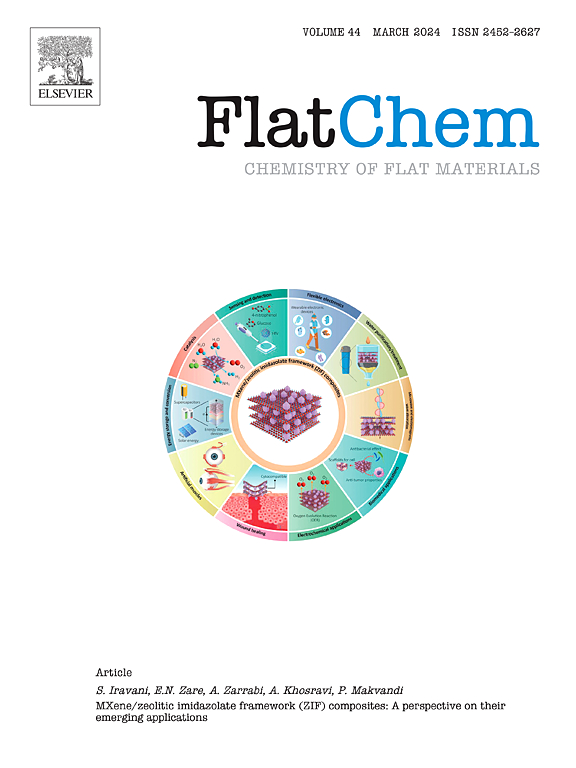Hydrogen binding on the B36 borophene nanoflake decorated with first row transition metal atoms: DFT, QTAIM and AIMD study
IF 6.2
3区 材料科学
Q2 CHEMISTRY, PHYSICAL
引用次数: 0
Abstract
Borophene, a monolayer of boron atoms, belongs to intensively studied two-dimensional “beyond-graphene” materials. The B36 borophene nanoflake is a finite size model system, containing a hexagonal vacancy similar to the ones present in β12 and χ3 borophene sheets. The hydrogen binding performance of B36 decorated with various transition metal atoms is investigated using density functional theory and quantum theory of atoms in molecules. Hydrogen is considered to become one of the crucial energy sources in future, hence, a search for effective hydrogen storage materials is of urge importance. Obtained results suggest that B36 decorated with Co, Ni, Fe, and Cu possess strong affinity to bind the H2 molecule via formation of η2-dihydrogen bonds. Among them, the strongest H2 binding is found for Co- and Ni-decorated B36. Furthermore, B36 decorated with Sc and Ti behave like H–H bond breakers while B36 decorated with Zn possess only negligible affinity to bind H2 molecule. The stability of the B36 decorated with Co and Ni is verified by ab initio molecular dynamics. The presented data may also serve as a basis for reference in future large-scale computational studies of borophene-based materials.

第一排过渡金属原子修饰B36硼罗芬纳米片上的氢结合:DFT、QTAIM和AIMD研究
硼罗芬是一种单层硼原子,属于被深入研究的二维“超越石墨烯”材料。B36硼罗芬纳米片是一个有限尺寸的模型系统,包含一个类似于β12和χ3硼罗芬片中存在的六边形空位。利用密度泛函理论和分子原子量子理论研究了不同过渡金属原子修饰的B36的氢结合性能。氢被认为是未来至关重要的能源之一,因此,寻找有效的储氢材料迫在眉睫。结果表明,以Co、Ni、Fe和Cu修饰的B36对H2分子具有很强的亲和力,可以形成η - 2-二氢键。其中,Co-和ni -修饰的B36的H2结合最强。此外,Sc和Ti修饰的B36具有H-H键的破断作用,而Zn修饰的B36对H2分子的亲和力可以忽略不计。用从头算分子动力学方法验证了Co和Ni修饰B36的稳定性。本文的数据也可为今后硼苯基材料的大规模计算研究提供参考依据。
本文章由计算机程序翻译,如有差异,请以英文原文为准。
求助全文
约1分钟内获得全文
求助全文
来源期刊

FlatChem
Multiple-
CiteScore
8.40
自引率
6.50%
发文量
104
审稿时长
26 days
期刊介绍:
FlatChem - Chemistry of Flat Materials, a new voice in the community, publishes original and significant, cutting-edge research related to the chemistry of graphene and related 2D & layered materials. The overall aim of the journal is to combine the chemistry and applications of these materials, where the submission of communications, full papers, and concepts should contain chemistry in a materials context, which can be both experimental and/or theoretical. In addition to original research articles, FlatChem also offers reviews, minireviews, highlights and perspectives on the future of this research area with the scientific leaders in fields related to Flat Materials. Topics of interest include, but are not limited to, the following: -Design, synthesis, applications and investigation of graphene, graphene related materials and other 2D & layered materials (for example Silicene, Germanene, Phosphorene, MXenes, Boron nitride, Transition metal dichalcogenides) -Characterization of these materials using all forms of spectroscopy and microscopy techniques -Chemical modification or functionalization and dispersion of these materials, as well as interactions with other materials -Exploring the surface chemistry of these materials for applications in: Sensors or detectors in electrochemical/Lab on a Chip devices, Composite materials, Membranes, Environment technology, Catalysis for energy storage and conversion (for example fuel cells, supercapacitors, batteries, hydrogen storage), Biomedical technology (drug delivery, biosensing, bioimaging)
 求助内容:
求助内容: 应助结果提醒方式:
应助结果提醒方式:


